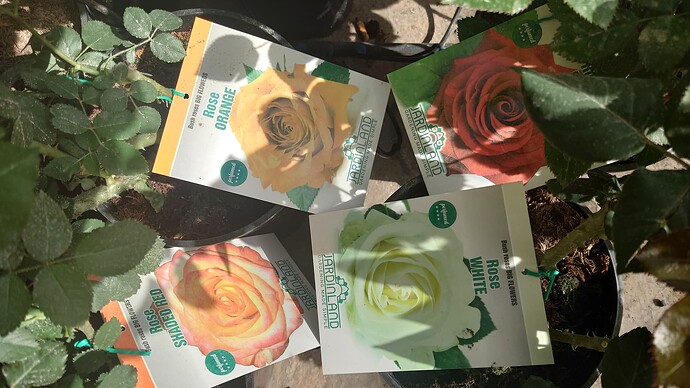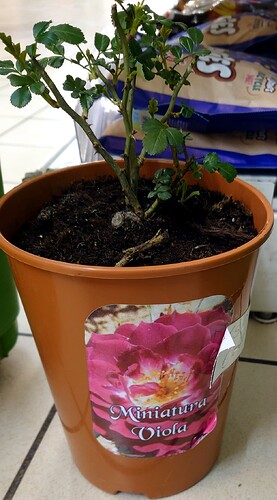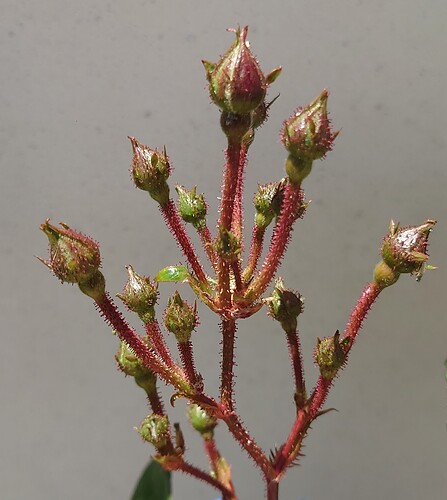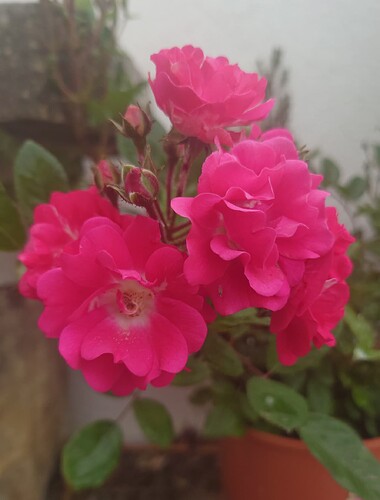I was at a smaller plant shop here this weekend and saw they had these potted roses.
I was surprised there was no indication of the names or even codes of any of these. I checked the tags, the pots, etc for any sort of code or reference but found nothing. These are all full-size roses, not minis.
How does something like this happen? Are they older varieties that have lost their patent? Or roses bred for a company with part of the deal being that they don’t get any identification?
Even grocery store minis usually have some kind of clue about their origin, at least the introducing company, but these had absolutely nothing. Jardinland is the name of the store, they are importers and have a nursery but they don’t breed roses .
I would not buy if there wasn’t at least some indication of the rose’s identity, but I guess lots of customers don’t care since they seem to sell anyway.
Trademarks are perpetual while plant patents expire. Hence, a grower cannot market a rose by the tradmarked name it bore in commerce while it was still under patent even though the patent has expired - unless, of course, they own the trademarked name.
Moreover, many breeding houses have realized that their IP is more lucrative than the plants themselves and have taken to recycling their trademarked names with newly patented varieties.
That being said, trademarks are not as secure as you might think. Honeycrisp was trademarked by the University of Minnesota which patented the apple by that name but some technicality put the trademark in doubt so anyone can sell Honeycrisp trees labeled as such, and they do.
That’s really interesting about patents and trademarks @Don , thank you!
So, how does a rose end up getting sold as just a generic “red”, “white” or “orange” like these? Does that mean these roses are still under patent, but being sold nameless to avoid paying?
This is a great discussion… I suspect they intend to just sell something cheap and don’t know what will be available to them at a bargain price for the specific color to put with the generic label. One thing I’ve noticed from at least one company is that they do put recently patented newer roses into especially bagged bareroot sleeves and have them labeled as non-patented other varieties of similar color (the label is of an old variety that is off patent that they won’t get in trouble for selling- no passing along the royalty to the breeder). I will resist sharing which wholesale company tends to do this… I wanted some of the older non patented roses for research and about half of them I bought at a local box store in bareroot bags were mislabeled. I knew the wholesale source and looked at their catalog and found that most mislabeled ones were clearly some of their recent higher valued patented roses. I suspect they just wanted to get some money for the plants versus dumping what didn’t sell and just put them into their more generic non-patented packages… This leads to confusion among consumers… I suspect people were routinely disqualified at rose shows having the wrong variety listed for their entries by astute judges having bought some of these mislabeled roses over the years.
At least with this vendor in your photo, they don’t even try to pretend the rose is some variety it isn’t :).
Easy! It’s been VERY common for a similar rose to be substituted for a named variety by suppliers. I have encountered current patented varieties labeled non patented names and sold for the cheaper price in bud and bloom. Some were obvious, others not as much. What appears to be the case is the grower had plants they needed to dump so they labeled them whatever was necessary to dump them. Those are likely a mix of patent and non patent varieties but tagging them by color relieves the grower of the “burden” of having to collect and pay royalties. Stuff like this happens (and has happened) all the time, particularly with contract growers and producers of “cheap” nursery stock.
Without naming an offender, would one of you give a concrete example of the roses we/you/us are talking about?
The first year it was out, Cherry Parfait sold as Double Delight. They look similar but Parfait doesn’t smell, DD, does. They had an over abundance of CP, which they weren’t able to sell, but Double Delight’s name recognition and the lower non patent price enabled them to unload that dead stock. There have been many situations such as that one. Appliance boxes of bare roots with their labels cut off, not body bags, just bare plants without soil or saw dust, in a discount store and marked $3 each. People bought the dried out plants like popcorn. The tags were obviously the round metal types as the wires that attached them remained on the plants with the round discs cut off them. Henry Fonda labeled “Peace”. Memorial Day as “Queen Elizabeth”. Neptune as “Sterling Silver”. You simply take a rose you want to dump and attach a non patent plastic label whose picture resembles it and voila! No accounting and no royalties required and your dead stock vanishes.
Gads sounds like buying flavoured and processed pollack instead of Dungeness crab meat for the garden salad. Looks the same.
This is fascinating, thank you very much @davidzlesak and @roseseek !
It is not uncommon to find anonymous roses in some of the plant shops here. Usually the labels are in Italian and glued to the pots, typically something along the lines of “rosa profumatissima rossa/ gialla/bianca” etc, with a picture.
I didn’t mean to single out that vendor, because these are quite common here, especially at this time of year during that shoulder between bare root and potted rose seasons.
Your replies help me understand how this happens. Presumably then, these were plants that didn’t sell during the winter in Italy and they ended up getting shipped, grown on a bit, and sold here in Malta. Somewhere along that process someone decided to avoid the “burden” of paying royalties and retag them.
Is this legal? It sounds a little dodgy. Then again, if these were plants that didn’t sell and were otherwise headed for the dumpster, then no royalties would have been paid either, so I’m not sure the hybridizer loses much?
It was once common in the US rose industry (perhaps in other plant types, also?) to pay royalties only on what sold. They might produce a hundred-thousand of a variety and only sell half, so royalties were only paid on half. David Austin changed that with his demands. His nursery required royalties for every bud used, whether it resulted in a plant or a sale or not. That changes the dynamic quite a bit. Previously, if the crop failed, no payment was necessary. Now, if payment isn’t made, there could be a case for breech of contract. Legal? Probably not. Worth the litigation to enforce? Also, probably not. Many ignore the legalities figuring it wouldn’t be worth the injured party’s efforts to enforce the property rights and they are usually correct. Too many nurseries “borrow” the photos from Help Me Find (when they are clearly marked “copyright”) without shame. MANY propagate patented plants without a care in the world. Unfortunately, unless there is the real potential for being held accountable for such thefts, too many figure since they can get away with it, just do it. Yes, the patent owners can lose quite a bit and too often, that quite a bit can make or break their ability to continue. Any serious breeding program gets expensive. If you’re a company with profits to help cover the expenses, great! If you have to depend upon the royalties to “support your habit”, then it can easily cause a disruption in your ability to keep breeding.
Thank you @roseseek ! I wasn’t aware of the royalties per bud used thing. Very interesting to learn about the impact of Austin on the broader practices in the industry.
That’s quite disturbing, especially if it leads to such consequences for independent hybridizers, since this is pretty widespread here.
I still don’t know if these are random pics of similar roses on the tags, or if they really show the actual rose being sold. I don’t want to presume anything. Most of the time the rose pictures on the tag look so generic that it’s impossible to tell if it’s an out of patent variety or not.
Perhaps if I come across one that has a more or less identifiable, distinctive pic, I will buy as a test it to see if the plant actually matches the variety on the picture, and if it’s under patent or not.
Well, that didn’t take long.
Was at the supermarket this morning, one of Malta’s big ones.
Checked out their garden section and they had a few anonymous roses there.
“Miniatura Viola”, sold for €8.50:
The picture is identical to the one on the website Pharmarosa for the variety “Diamond Eyes”, bred by Tom Carruth, introduced in 2013, still under patent.
I have bought from Pharmarosa before, this is not their pot style nor do they glue labels to them like that. I doubt the rose itself came from Pharmarosa.
I bought it. Now to wait for it to bloom to see if the anonymous “purple miniature” really is Diamond Eyes, or if they just ripped off a picture.
If it does turn out to be Diamond Eyes I would like to wire royalty money to the patent holder to make it right.
Very nice sleuthing!
The anonymous supermarket rose is about to bloom and I think it might not be the rose in the picture that was glued to the pot.
Looking at pictures of Diamond Eyes on HMF I am not seeing this level of cluster blooming, nor the hairyness of the little bud stems. So now I really have no idea what the “mystery meat” is.
I’ll post more pics when the blooms open.
Hello SeasideRooftop!
Many thanks for sharing this issue with us. This rose looks really interesting.I am also curious about the blossoms. Wait and see.
If I had to guess, based upon what it’s supposed to be and the appearance of that bloom cluster, I would guess Baby Faurax.
If it’s Baby Faurax, at least I won’t have to feel bad about royalties not getting paid to the breeder, so that would be the best possible outcome of this experiment!
I think you are right @roseseek !
It does look like some of the Baby Faurax pics on HMF. Not getting anything close to purple though, I guess it’s a climate thing?
It has no detectable scent and it hardly had a day without mildew since it’s been here. I guess it doesn’t like the seaside.
I don’t think so, based upon the color. It looks more like one of the other “red” multiflora polys. Faurax is most often really PURPLE and with smaller petals. It’s pretty, whatever it is.
Thank you @roseseek .
Well, I am back to square one with the mystery meat!




